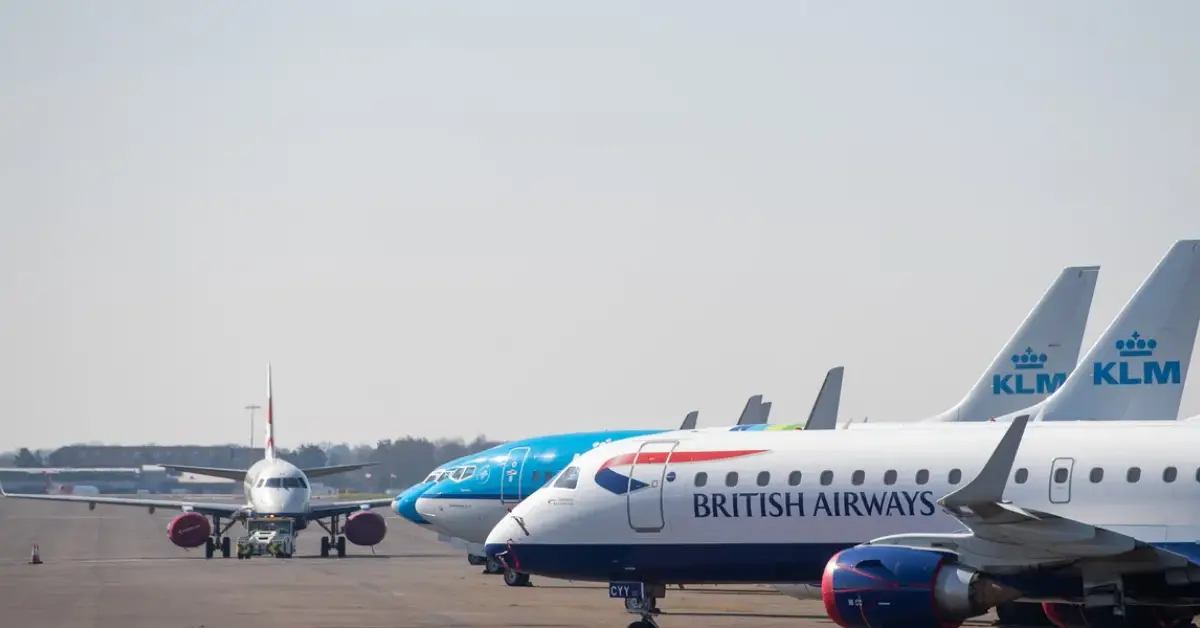A British airport was forced to close after a plane’s undercarriage “collapsed” following an emergency landing, resulting in flight cancellations and diversions. The incident, which occurred at Norwich Airport, resulted in significant disruptions, affecting flights not only at the airport but also causing ripple effects across the UK.
The Incident at Norwich Airport
The emergency at Norwich Airport occurred at approximately 1:48 p.m. on the day of the incident. A light aircraft, which had two passengers onboard, was forced to make an emergency landing at the airport after reporting an issue with its undercarriage. The plane successfully landed, but as it touched down, the undercarriage collapsed, prompting emergency services to rush to the scene.
Fortunately, both passengers on board were unharmed, and emergency fire and ambulance services were quick to respond. The two individuals were safely removed from the aircraft without sustaining any injuries, although the incident led to major disruptions at the airport.
Airport Runway Closure and Flight Cancellations
As the plane’s undercarriage was being recovered, the runway at Norwich Airport was closed. The airport confirmed that the runway would remain shut until at least 5 p.m. this same day, forcing several flights to be cancelled or diverted. This closure affected various flight schedules, leaving some passengers stranded and others rerouted to alternative airports.

One of the most significant impacts was felt by passengers aboard an inbound TUI flight from Tenerife. Due to the closure of Norwich Airport’s runway, the TUI flight was diverted to Stansted Airport instead. The diversion of this flight further complicated the already tense situation at Norwich, as Stansted Airport is located approximately 50 miles south of Norwich, adding further delays for travellers.
In addition to the TUI flight diversion, another major disruption came in the form of a cancelled KLM flight from Norwich to Amsterdam. The flight, scheduled for 2:05 p.m., was grounded due to the runway closure. Passengers who had been looking forward to their journey were forced to find alternative arrangements, with the airport authorities working quickly to offer assistance.
What Caused the Emergency Landing?
According to a spokesperson from Norwich Airport, the incident occurred when the light aircraft, carrying two people, diverted to Norwich after experiencing an issue with its undercarriage. The undercarriage, a vital component for landing, malfunctioned and collapsed when the plane touched down on the runway. This type of mechanical issue is considered rare but can lead to severe consequences if not handled correctly.
Fortunately, the emergency response at Norwich was prompt and efficient, ensuring the safety of the passengers and crew aboard the plane. Emergency fire services were immediately dispatched to the scene, followed by ambulance personnel to ensure the health and safety of everyone involved.
While the cause of the undercarriage failure is still under investigation, mechanical failures of this nature are not uncommon in aviation. The undercarriage system of an aircraft includes various complex components that must work in tandem to ensure a safe landing. Any malfunction in these components can pose a risk to the plane and its occupants, which is why immediate action is necessary in such situations.
Impact on Other Airports
As the incident at Norwich Airport unfolded, the ripple effects were felt across the UK aviation network. Other airports, already struggling with delays, had to manage the overflow of diverted flights and cancellations. Gatwick Airport, known for being one of the busiest airports in the UK, retained its unfortunate position as the country’s worst airport for flight delays in 2024.
According to a Gatwick spokesperson, European air traffic control restrictions continued to impact the airport’s operations, with departures averaging more than 23 minutes behind schedule. The airport authority stated that they had implemented a “robust plan” in collaboration with airlines to improve punctuality and on-time performance in 2025. Despite the efforts, travellers at Gatwick have faced ongoing challenges with delays, and it remains to be seen whether the airport will be able to resolve these ongoing issues.
Birmingham Airport, another major UK hub, also recorded poor punctuality performance, with average delays exceeding 21 minutes. This placed the airport second on the UK’s list of worst delays. Manchester Airport followed closely behind, with an average delay of 20 minutes per flight.
On the other end of the spectrum, Belfast City Airport, also known as George Best Belfast City Airport, emerged as the leader in punctuality. For the second consecutive year, Belfast recorded the best on-time performance in the UK, with typical delays averaging less than 12 minutes. This achievement demonstrates the effectiveness of airport management and operational efficiency in dealing with delays and disruptions.
What Happens Next?
The situation at Norwich Airport is expected to improve by 5 p.m. as authorities work to recover the aircraft and clear the runway for normal operations. However, the impact of the disruption may extend well beyond the immediate closure, with travelers having to adjust their plans for the day.
Passengers affected by flight cancellations or diversions will likely need to seek alternative arrangements. Norwich Airport authorities have promised to assist those stranded or facing major delays. However, given the short notice and the scale of the incident, many travelers may still face frustration and inconvenience as they seek to rearrange their travel plans.
The closure of the runway and the diversion of flights also highlight the ongoing challenges that airports in the UK face when dealing with mechanical issues, emergencies, and flight disruptions. While the prompt response to the emergency was commendable, it also underscores the importance of having contingency plans in place to minimise the ripple effects of such incidents.
How the Situation Reflects Broader Trends in UK Aviation
The Norwich Airport incident and the ongoing struggles at airports like Gatwick and Birmingham point to broader trends in UK aviation. The aviation industry has faced significant challenges over the past few years, especially in the wake of the COVID-19 pandemic. Air travel demand has fluctuated, and airports have had to adapt to new safety protocols and operational challenges.
At the same time, the need for better infrastructure, efficient air traffic control, and effective management systems has never been greater. While some airports like Belfast City have demonstrated strong performance in terms of punctuality, others like Gatwick continue to struggle with delays.
Airports across the UK are likely to face continued pressure in the years to come, especially with the rapid increase in travel demand expected in the post-pandemic era. To remain competitive and offer reliable service to passengers, UK airports must address the root causes of delays, improve customer service, and invest in long-term infrastructure upgrades.
Conclusion
The closure of Norwich Airport after the emergency landing of a light aircraft highlights the challenges faced by the UK’s aviation industry. While the immediate response to the incident was successful, with no injuries reported, the ripple effects on other airports and passengers’ travel plans are significant. As UK airports continue to grapple with operational challenges, it will be essential for authorities to put in place robust plans to minimise the impact of disruptions and improve the overall passenger experience.
The incident also highlights the ongoing struggles of some UK airports with delays and punctuality, underscoring the need for further improvements to ensure smooth and efficient operations across the country’s aviation network.
Disclaimer: This article has been meticulously fact-checked by our team to ensure accuracy and uphold transparency. We strive to deliver trustworthy and dependable content to our readers.




